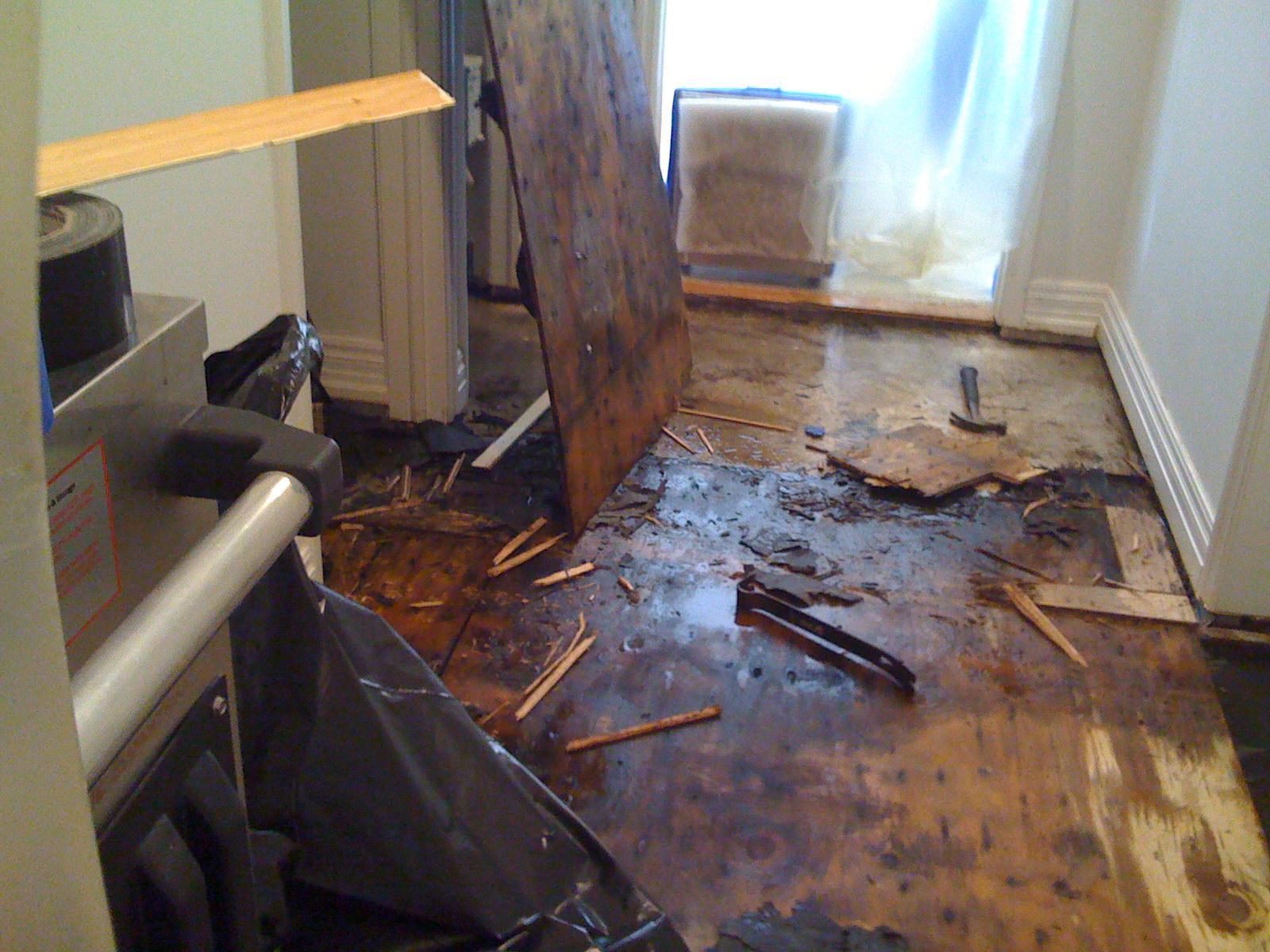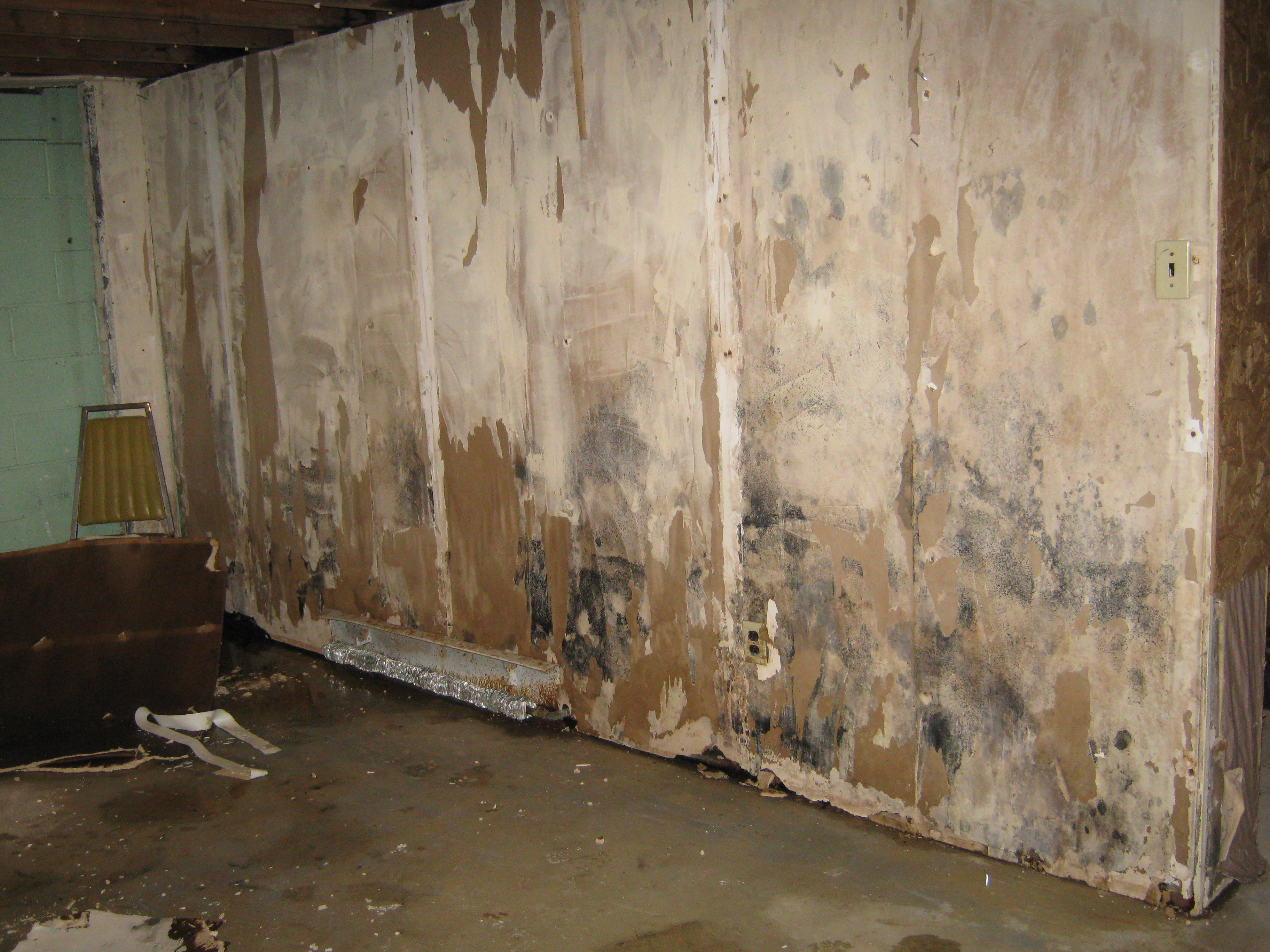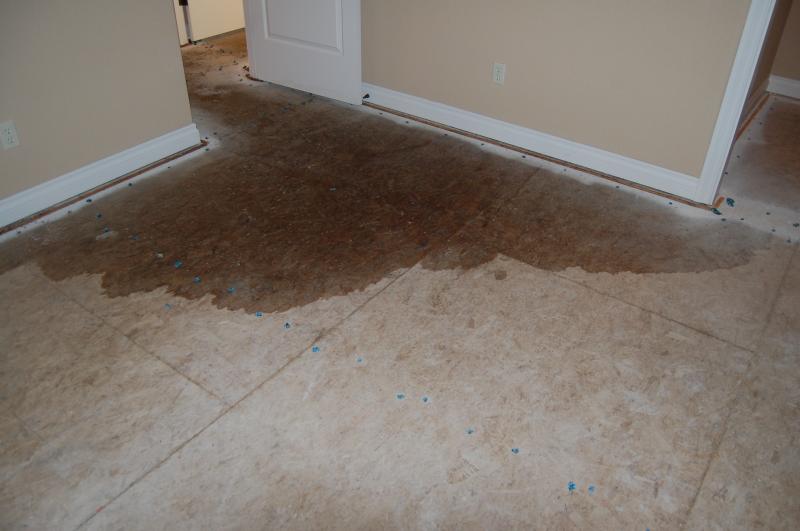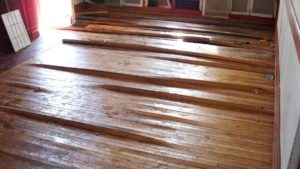Floor Damage after a Hurricane or Flood
Our previous post touched on Flood Damage, Mold and the Rebuilding of Your Home. In this post, we’re discussing FLOOR-DAMAGE after a hurricane/and or flood and how different flooring materials hold-up to such circumstances. We’ll also discuss why it is so important to take the right steps in remedying any damage that may have occurred.

Water Damage to Plywood Subfloor
With the passing and destruction of Hurricane Harvey and Hurricane Irma and with a couple of new Hurricanes making their way to landfall, the inevitable threat of sitting flood water has never been more real. Unfortunately, the chances of severe damage to the flooring in your home are high if you live in an area that may be hit by one of these catastrophic storms, and most likely, replacement will be necessary.
So how does someone assess the damage to their floors once the water has receded?
There are a few things that need to be considered when assessing the extent of the damage caused by the flood-water.
– Water will find its way into every crevice in your home that it can. So understanding that even if the surface of the floor “looks dry,” that doesn’t necessarily mean you’re free and clear from water-damage in areas that you can’t see.
– What “type” of water caused the floor. Was is a backed up septic? Burst pipe? Hurricane flood waters? Depending on the type of flood water, even if the floors weren’t damaged, for sanitary reasons, you may want to replace them entirely.
– If your home has been subject to sitting water for a good amount of time (days or longer) the chances are, not only your flooring will have to be replaced, but your subfloor will also need assessment. If you have a plywood subfloor, the damage could be irreversible, and you may need to replace that as well. If you have a cement subfloor, proper drying and then sealing should to be done before new flooring is installed over it.
– The biggest concern a homeowner faces is the impeding threat of the growth of mold beneath their flooring. It’s incredibly important that you make sure that your subfloors are thoroughly dried, treated and/or sealed before installing a new floor covering.


Water Damage to a Plywood Subfloor
With so many different types of floor coverings on the market today, and each boasting their own qualities, how do you know if your flooring REALLY needs to be replaced or if it can be salvaged and re-used? Below, we go down the list of common floor coverings and give you a general idea on how well they’ll hold up to flood damage. Keep in mind that this is just a generalization, and every circumstance is different. There is an enormous difference between a pipe bursting, and water being cleaned up within the first few hours, and days of sitting, sewage-infused hurricane flood-water.
- TILE – Of all floor coverings, tile is the most resistant to flood and water damage. Tile, itself is a waterproof material, however, that doesn’t mean that if there is a flood, the water won’t find it’s way through the perimeter and seep into the subfloor. However, if you have tile flooring, you, most likely, have a cement subfloor, which is a plus. If the flood-water was minor and your tile wasn’t submerged for a long period of time, you may be able to dry everything out with dehumidifiers, etc. Just be aware that if water gets trapped somewhere beneath the tile, it is now susceptible to the growth of mold, so it’s crucial that all the moisture left over is taken care of. If your home has had sitting water for a long period of time, it will be more difficult to remove the moisture. With sitting water, even with a cement slab, chances are your cement slab is saturated and the tile needs to be removed to properly dry the slab. Remember, if the moisture has no way of escaping, (trapped in the slab under the tile) the chances of the growth of toxic mold are high, and there is no sense in putting your family at risk.
- Can you re-use the tile that is pulled up?
– This is a tricky question; Technically, yes. Considering you’re able to remove it without it breaking. However, the time it will take you to, not only, carefully remove the tile without cracking it, and then chiseling off the thin-set mortar that is adhered to the bottom of the tile will prove to be not really worth the effort.
- LAMINATE – Laminate doesn’t like water or moisture of any kind. No matter how great the product sounds, or how “water-resistant” the manufacturer claims it is, once water of any kind come in contact with laminate, chances are it will be completely ruined. There are a few different and “higher-end” laminates on the market that won’t blow up like wet cardboard like the “lower-end” laminate materials, but will still be damaged by any type of flooding. The damage won’t be as extensive, but the material will still need to be replaced. The warping, cupping and de-laminating of the materials surface will be irreversible. Laminate flooring cannot be refinished or sanded in any way to make it look new again. Once it’s damaged, it needs to be replaced.
- Can you re-install the laminate if it’s pulled up and dried out?
– Absolutely not. You need to understand that only the surface of the laminate material is water-resistant, meaning once moisture of any kind, even extreme humidity, come in contact with the rest of the material, it gets damaged. The material holds onto the moisture and expands, damaging its shape and the important tongue and grooves which lock it together.
- HARDWOOD – Now it get’s a bit trickier; we can certainly understand how you may want to hold onto your solid hardwood flooring at any cost, a hardwood floor is an investment in your home, and it’s not something that’s easily let go of. If you have hardwood flooring in your home, the damage caused by flood-water really depends on a lot of different circumstances –
- What is the species of the hardwood? You may find that some naturally oily exotic species of hardwood may hold up much better than some of our domestic hardwoods when coming in contact to high humidity or direct water.
- How is your flooring installed? Is it glued down to a cement subfloor or stapled into a wood subfloor?
- How extensive was the flooding in your home, and how much time did the water have to absorb into the wood?
- How long ago was your hardwood floor sealed and finished? A newly refinished hardwood floor will hold up a bit better than an older hardwood floor which shows wear in its finish.
In general, wood is a naturally porous material, and is really sensitive to moisture levels and, of course, direct contact with water. In some cases, where the exposure to moisture/water is slight, and it’s caught quickly enough, you may be able to remove the excess moisture by using dehumidifiers, air conditioning, fans, etc., and simply re-finish your flooring. However, extreme moisture and sitting water, will have more than enough time to seep into the seams of your hardwood flooring, reaching the subfloor and saturating that as well, creating all kinds of warping issues, ultimately leading to replacing it completely. If the water-damage was contained to just a certain area of your flooring, it may be possible to repair (remove and replace with new) only the section that was damaged.

– Is it possible to re-use the hardwood that has been removed?
– Unfortunately, no, not as hardwood flooring. If your hardwood flooring is so damaged that it has to be removed, the warping that occurs from exposure to high moisture content will prevent you from being able to re-install it. Even the process of ripping-up the hardwood, usually damages it altogether. Remember that the important thing is making sure there is no trapped moisture under your flooring or in your subfloor. There have been many instances where a homeowner has thought the flooring to be “dry” but after 6 months, the flooring planks showed discoloring from the growth of mildew and mold from trapped moisture beneath them.
– Try to repurpose/reclaim your damaged hardwood if at all possible.
- COREtec – This popular floor covering will probably hold up the best in instances of flooding. COREtec is water-resistant all the way around, and because it’s installed as a floating system, it can be (very carefully) picked up, dried out and re-used in many cases. However, in extreme cases of flooding, like the flood-waters that Hurricane Harvey caused, even COREtec will show some warping after days of being submerged in water and have to be replaced. Keep in mind that if you have COREtec flooring, and your home experiences any kind of flooding, COREtec’s vinyl top layer will trap any moisture underneath it, allowing for mold to grow, so it’s important to make sure your subfloor is allowed proper time to thoroughly dry.
- LUXURY VINYL – The Vinyl material itself, is completely waterproof, however, sitting flood-waters will seep into the seams, and in many cases, causing the adhesive to fail. The Vinyl material may not be damaged, but if water finds its way underneath, it will be trapped, allowing for the growth of mold.
- Can you re-install glued-down vinyl if it’s ripped up? Again, this is a bit tricky because the material itself should be unharmed by the water. However, when Vinyl is ripped up, the adhesive usually gets ripped up with it, making it almost impossible to re-install it, and the time and effort it will take to attempt to scrape the left over glue off the backs of the luxury vinyl planks will prove to be not worth it.
- BASE, SHOE and TRIM – With finishes, you have to consider a few things; first, what is it made out of; If your trim is made out of MDF (Medium Density Fiberboard), the chances of it not being damaged by direct contact to water are incredibly slim. But being that it is relatively inexpensive (compared to solid wood trim) it won’t be a big expense to just remove and replace it. If your home has a solid wood, like many older homes here in the Northeast who have Pine trim moldings, you may be able to dry them out and keep it. However, assessing water damage is really a case by case matter, and all depends on the severity of the flood-water, and the length of time it had to penetrate the material in question.
38 Comments
Pingback:
Pingback:
Pingback:
Pingback:
Pingback:
Pingback:
Pingback:
Pingback:
Pingback:
Pingback:
Pingback:
Pingback:
Pingback:
Pingback:
Pingback:
Pingback:
Pingback:
Pingback:
Pingback:
Pingback:
Pingback:
Pingback:
Pingback:
Pingback:
Pingback:
Pingback:
Pingback:
Pingback:
Pingback:
Pingback:
Pingback:
Pingback:
Pingback:
Pingback:
Pingback:
Pingback:
Pingback:
Pingback: